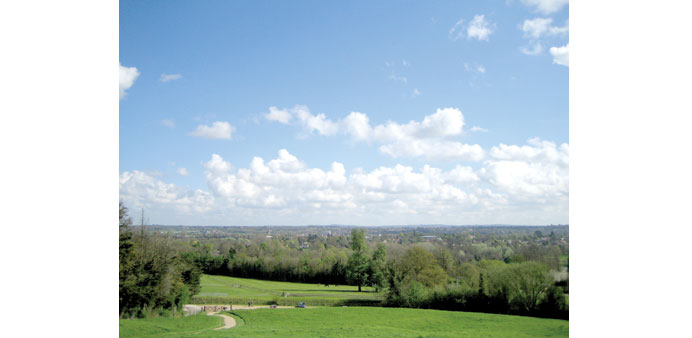By Steff Gaulter
My teacher at the UK Met Office used to joke that the British summer consisted of two sunny days followed by a thunderstorm. If that were true, then Britain has already seen its summer this year, and it was quite a spectacular one.
Heat always brings mixed emotions in the UK. Most Brits complain that they never see the sun, but when it actually shines, it gets hot and British people can’t cope with that either. To be fair, it’s not just the British people that can’t cope with the heat, the British infrastructure can’t cope either. The homes don’t have air conditioning, the train tracks have a tendency to warp, and if it gets really hot then the tarmac has been known to melt as well.
At the end of June and the beginning of July, it was certainly tarmac-melting weather in the UK. Hot air was drawn north from Africa, causing the temperatures to rocket. This hot air had already brought record breaking temperatures to Spain; Madrid had reported 39.1C (102F) on June 28, the hottest June day on record. A few days later, the heat spread across the UK. On July 1, Heathrow airport recorded a temperature of 36.7C (98F) the hottest temperature ever recorded in the UK in July and only narrowly short of the highest temperature ever recorded in the UK. The highest ever UK maximum still stands at 38.5C (101.3F), which was recorded in 2003 in Faversham in Kent.
Just before you start chuckling at the lily-livered Brits not being able to cope with temperatures which are much lower than we get in Qatar, let’s put this temperature into context. On July 1, Heathrow’s temperature was only 3.3C less hot than Doha was on the same day, so it was clearly very hot. It’s also worth mentioning that on July 1, the maximum temperature in Doha was between 10 and 11am, and it had dropped to 36C by 2pm.
Imagine going outside at 2pm today and standing in the sunshine waiting for a train, or perhaps sitting in your house trying to read a book with the air conditioning switched off. The heat is felt more acutely in the UK than it is in Qatar because the way of life in the UK is very different; people spend more time on public transport and walking outside. It’s also worth mentioning that the homes in Britain are designed to keep the heat in, rather than let it out. They don’t have the high ceilings and tiled floors that we do in Qatar, instead the homes are small and poorly ventilated. In short, Britain is not prepared for hot weather.
In the summer, there are plenty of outdoor events that are planned in the hope of catching any unusually favourable weather. Normally the concern is that the events will be washed out, rather than they’ll be endured in blistering heat. This year though, the soaring temperatures struck during the Wimbledon tennis championships. Despite the heat, organisers decided that play must go on, but the weather took its toll; dozens of spectators had to be treated by paramedics and a ball boy collapsed on Centre Court.
It’s no wonder that after the stiflingly hot day, most people were relieved when the thunderstorms started to develop. Thunderstorms are helpful in cooling things down and clearing the humidity, but these storms were ferocious. The intense heat during the day had ensured there was a lot of energy in the atmosphere and the resulting thunderstorms were spectacular.
The thunderstorms brought hazardous conditions. Swanage on the south coast reported 27mm (1.1 inches) of rain in just one hour, which is just over half the rainfall that is expected in the entire month. The deluge triggered flash floods which inundated people’s homes, strong winds tore tiles from people’s buildings and hail the size of golf balls smashed windows and dented cars.
The lightning that accompanied the storms was spectacular and the next day the newspapers were inundated with dramatic photos. The Met Office reported that over 30,000 lightning strikes had illuminated the skies, but you’ll be pleased to know they didn’t have to count them manually.
A bolt of lightning produces a pulse of electromagnetic energy. We see this as lighting, but the energy isn’t just confined to frequencies that are visible, it spans many other frequencies as well. Some of these we can hear as static on an AM radio and others are at much lower frequencies.
The Met Office uses very low frequencies to detect lightning. One single detector can be used to identify a strike, and several can be used to locate it. The electromagnetic energy travels at a constant speed, the speed of light, so if you hear one lightning strike at one point before you hear it at another, then you know it is closer to the first point than the second.
Like many countries, the UK Met Office has a network of lightning detectors that it uses to determine the exact location of thunderstorms, but there are a few simple techniques you can use from the safety of your home. If you can see the lightning, you can easily determine how far away is the storm by counting the seconds and dividing by three; this will tell you how many kilometres away is the lightning. For storms that are further afield, you can use any radio tuned to AM as your lightning detector. Simply tune into a frequency that doesn’t have any reception and listen for something that sounds like someone wringing a wad of plastic bubble wrap. With this technique you can sometimes ‘hear’ lightning that is hundreds of kilometres away. Sadly, here in Qatar we are unlikely to detect any thunderstorms at this time of year, but it may be something to keep in mind for later in the year, when you find yourself stuck in traffic.

PLEASANT: Summers in the UK are usually pleasant when the sun shines. Photo: Joolz~commonswiki/Wikipedia


